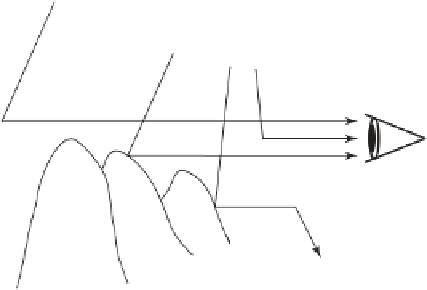Environmental Engineering Reference
In-Depth Information
4
3
1
2
Figure 9.14
Reflection and scattering of light rays. Ray 1, reflected from object; Ray 2, reflected but
scattered out of view; Ray 3, scattered by particles between object and observer into view; Ray 4, scattered
by background particles. Adapted from Seinfeld, J. and S. N. Pandis, 1998.
Atmospheric Chemistry and
Physics.
New York: Wiley Interscience Pub.
The scattering of light causes a loss of contrast. This is depicted in Figure 9.14. A part of the
incoming sunlight is reflected from the object and reaches the retina of the eye (ray 1). A part of the
reflected light is scattered out by particles in the air and does not reach the retina (ray 2). A part of
the incoming sunlight is scattered by particles between the object and the eye, reaching the retina,
but this ray causes a loss of contrast (ray 3). Finally, a part of the incoming sunlight is scattered by
particles behind the object, reaching the retina, but with a loss of contrast (ray 4). The consequence
of rays 2 to 4 is a loss of contrast of the object against the background. Empirically, it has been
shown that an object is no longer visible when the contrast against the background is less than 2%.
This is called the threshold contrast and can be expressed as
I
bkg
−
I
obj
C
x
=
≥
2%
(9.30)
I
obj
where
C
x
is the contrast at distance
x
meters,
I
bkg
is the intensity of light rays from the background,
and
I
obj
is the intensity of light rays from the object. Alternatively, the contrast relationship can be
written
C
x
=
C
0
exp
(
−
b
ext
x
)
(9.31)
where
C
0
is the contrast at zero distance, and
b
ext
is the extinction coefficient in m
−
1
. Threshold
contrast is when
C
x
/
C
0
=
0
.
02, thus
−
b
ext
x
=
ln
(
0
.
02
)
=−
3
.
912
(9.32)
Equation (9.32) is called the Koschmieder relationship. It gives the extinction coefficient
b
ext
when
an object loses its contrast against the background at a distance
x
meters. In clear air
b
ext
=
E
(
−
5
)






























































